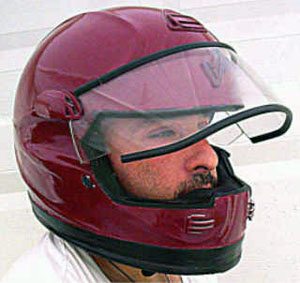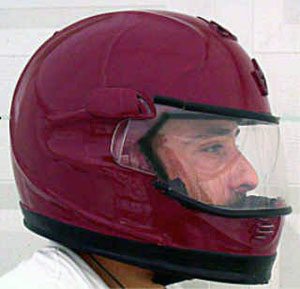This information was provided by Michael Puleo, the inventor of the “Vexon” motorcycle helmet. It is presented here for the information of our visitors.
Note: For informational use only. All material and photographs are Copyright © webWorld International, LLC – 2000-2011. All rights reserved. See the webBikeWorld® Site Info page. NOTE: Product specifications, features and details may change or differ from our descriptions. Always check before purchasing. Read the Terms and Conditions!

Greater peripheral and frontal views of this helmet are achieved by a unique structure of the lower and side view window rims, by narrowing the thickness of the helmet’s shell at the side rims near the wearer’s eye level, and by redesigning the view window visor.
The lower rim of the view window drops in at least a single step fashion at locations substantially below each of the wearer’s eyes as it extends towards the rear of the view window rims at the sides. This structural design increases the wearer’s frontal field of view without compromising the strength and / or safety of the helmet.
The side rims of the view window at eye level are not of the same configuration, as compared to conventional full-face speed helmets. The rear of the view window of conventional helmets at eye level are rounded. The side rims of this inventive helmet has a straight slant that extends backwards from bottom to top toward the auditory canal and then at about eye level angles forward to the top rim of the view window.
The deepest portion of the side rims of the view window is located at the wearer’s eye level. In addition, a portion of the inner padding located on the right and left sides of this inventive helmet, at eye level, is minimally reduced. The minimally reduced padding is achieved by narrowing the sides of the helmet’s shell at eye level.
The narrowed portions becomes less narrow towards the middle to back of the helmet. This preferred structure maximizes the user’s peripheral view without a significant reduction in the protective properties of the helmet. This enhancement will enable the wearer to make quicker split-second navigational decisions. The visor at the sides have been redesigned to fit into the narrowed portions, in the helmet’s shell, at eye level.
This inventive helmet decreases the chance of an accident occurring because the rider lost sight of an object in the blind spots associated with conventional helmets. This helmet greatly reduces the distractions caused by the wearer’s eyes focusing on the inside of the view window on both padding and rim when operating a vehicle.
In conclusion, it is the objective of this inventive helmet to give the wearer the feeling as if he or she is not wearing a helmet at all. This results from not seeing any part of the inner view window, including the padding, especially when turning your head to make lane changes on a busy highway or when 30-40 racing opponents are surrounding you in a Super-Bike race, traveling at speeds in excess of 125 mph and you are striving to take a leading position.
As the speed of vehicles continues to increase, so must the technology of protective gear, such as helmets.
- The side rims of the view window of the Vexon helmet are further back than the conventional helmet, allowing an unobstructed peripheral view. They slant backwards and then at about eye level, angle forward to the top rim, unlike the rounded configuration of conventional helmets. This significantly eliminates the eyes from focusing on the side rims and the padding of the helmet when looking out of the view window at the sides.
- The step-down cutouts to the lower rim of the view window below each eye helps to improve frontal view. These step-down cutouts widen the view window from top to bottom, unlike the conventional helmet. These step-down cutouts work in conjunction with the configuration of the side rims of the view window to improve peripheral vision.
- The Vexon helmet’s shell has narrowed portions at the sides at eye level, contributing to enhancing peripheral vision. These narrowed portions resurface at the middle of the helmet. The view window’s visor has been modified to fit into the helmet’s narrowed portions. The inner padding thickness of this helmet meets DOT standards.
- A DOT / SNELL helmet was modified to incorporate the Vexon’s unique features. Product developer’s prototype can be furnished upon request.
More information can be found on the Vexon website, including contact information for the inventor, who is currently seeking licensing agreements for this design.


